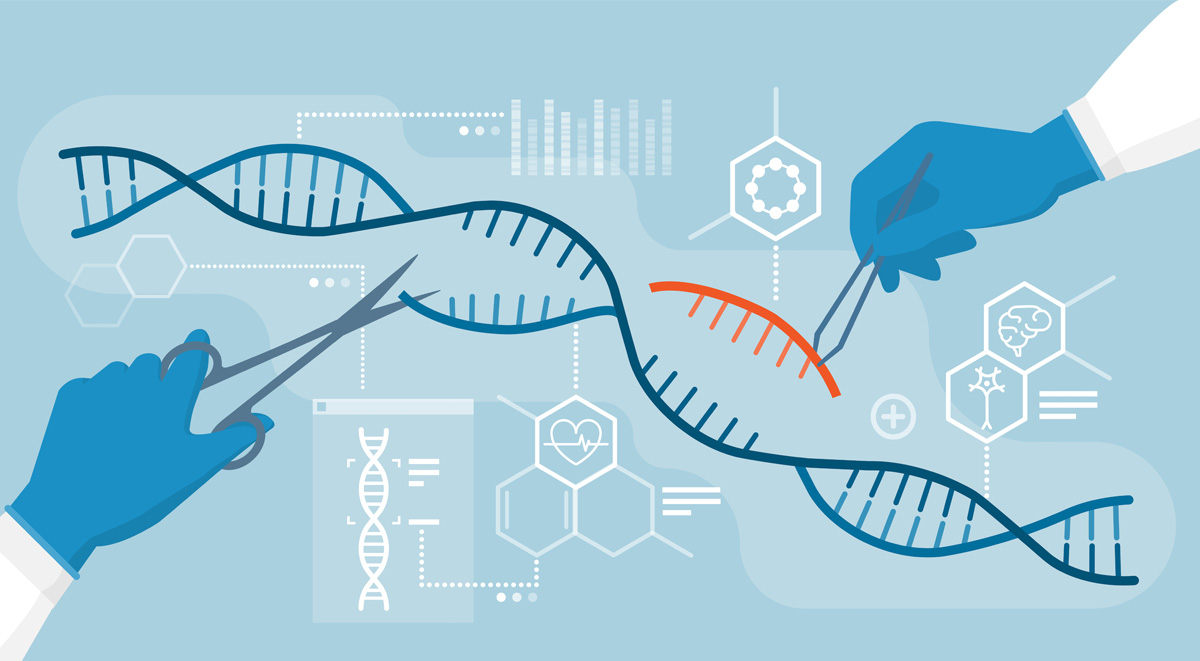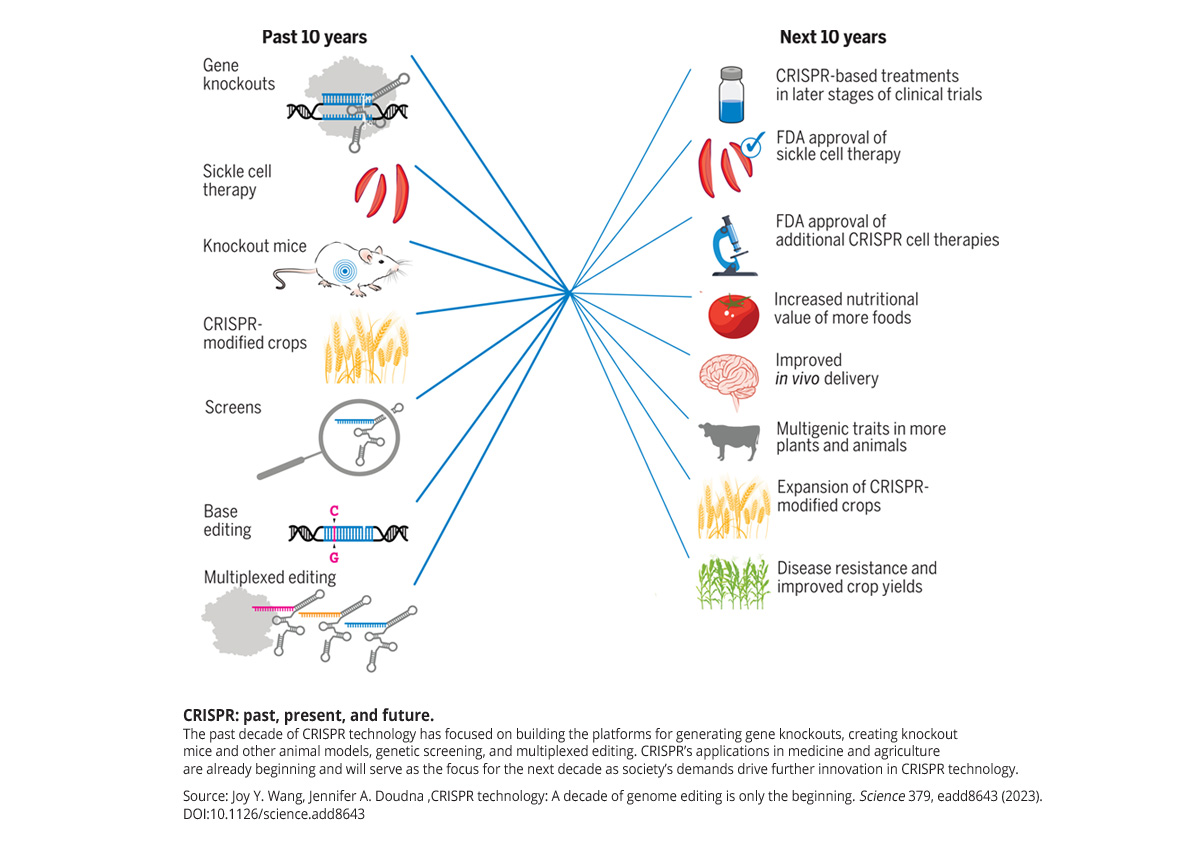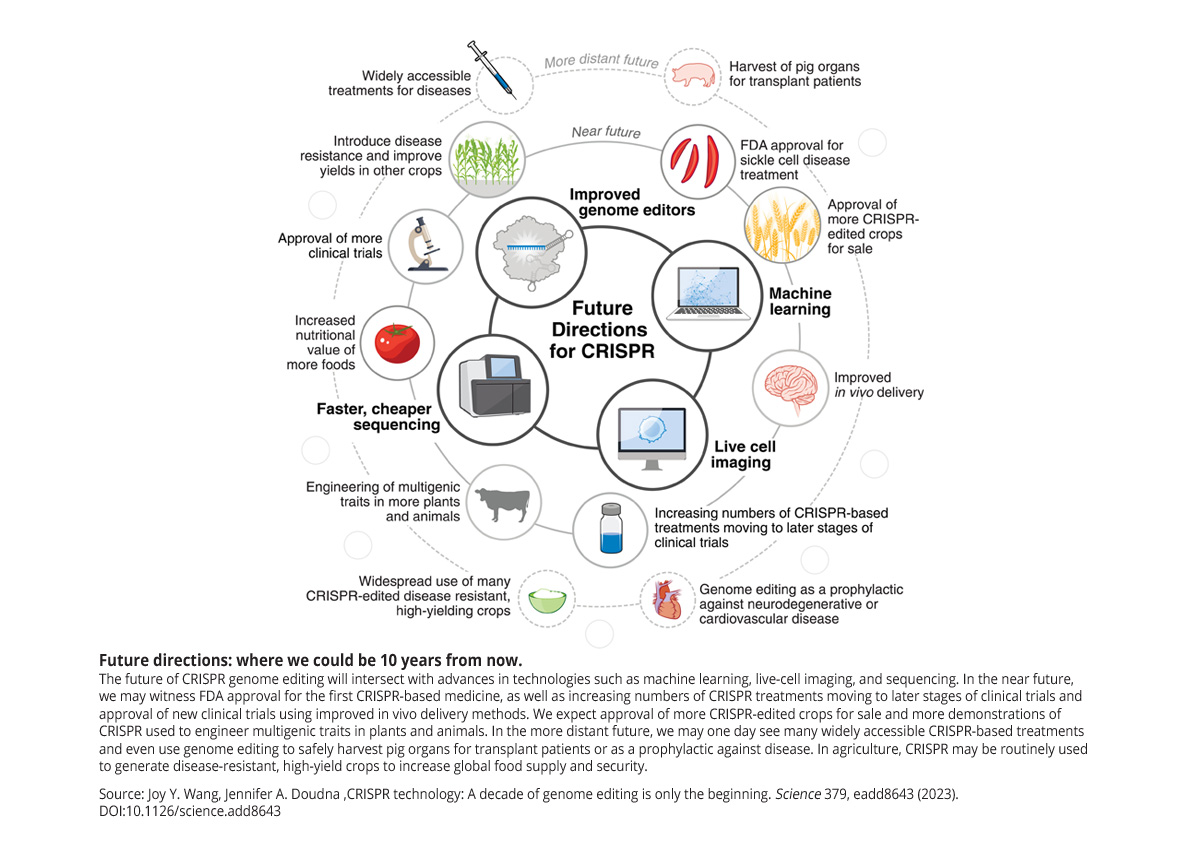The First Decade of CRISPR: Advances and Outlook
| |
In the past decade, after the release of CRISPR-Cas9 as a genome-editing tool, it has revolutionized biological research. CRISPR and its applications have changed how biological research is done. A review by Nobel Laureate and CRISPR pioneer Jennifer A. Doudna of the Innovative Genomics Institute, University of California, Berkeley, and Joy Y. Wang, also from UC Berkeley, explores the origins, applications, and limitations of this technology. They discuss advancements, future directions, and real-world examples of CRISPR's impact on medicine and agriculture, highlighting its potential to shape various aspects of society.

CRISPR-Cas9, short for clustered regularly interspaced short palindromic repeats (CRISPR)-CRISPR-associated protein 9 (Cas9), is the most widely used genome editing editor. This genome editing tool's power comes from its chemical mechanism of DNA cutting at a site dictated by RNA-determined sequence recognition. CRISPR acts as a precise pair of molecular scissors that can cut a target DNA sequence, directed by a customizable guide. CRISPR allows scientists to rewrite the genetic code in almost any organism. It is simpler, cheaper, and more precise than previous gene editing techniques.
The CRISPR system is made up of two key parts: a CRISPR-associated (Cas) nuclease, which binds and cuts DNA, and a guide RNA sequence (gRNA), which directs the Cas nuclease to its target. It was discovered in bacterial immune systems, where it cuts the DNA of invading viruses and disables them. Once the molecular mechanism for its DNA-cleaving ability was discovered, it was quickly developed as a tool for editing genomes.
The first examples of engineered CRISPR-Cas involved transcriptional repression or activation to silence or up-regulate specific genes. Other forms of engineered Cas9 are fused to enzymes that enable individual nucleobase editing, chromatin modification, or sequence insertion. Other Cas proteins, including RNA-targeting proteins, have been explored as genome-modifying tools, enabled by discovery efforts and extensive biochemical and structural characterization. Some of these enzymes have also been harnessed for the development of imaging methods and diagnostic approaches.
CRISPR Advances
The past decade has witnessed the discovery, engineering, and deployment of RNA-programmed genome editors across many applications, including agriculture, healthcare, and other industries. CRISPR technology has enabled agricultural advances, including slick-coat cattle, red sea bream that grows larger, tiger puffer with increased appetite, high-oleic soybean, tomato with increased gamma-aminobutyric acid (GABA), high-starch maize, and reduced browning banana.
- March 2019: High Oleic Soybean Oil called CalynoTM, developed by experts from Calyxt, Inc., became the first-ever gene-edited food product to successfully undergo review by the USDA and FDA and be commercialized in the U.S.
- September 2021: Japanese startup Regional Fish Co., Ltd. began selling a gene-edited "Madai" red sea bream. The gene-edited fish was developed using CRISPR gene editing technology to knock out a protein that suppresses muscle growth. The edited fish has an edible part of about 1.2-1.6 times.
- September 2021: Sanatech Seed Co., Ltd. and Pioneer EcoScience Co, Ltd. started the sale of their genome-edited tomatoes with increased GABA called Sicilian Rouge High GABA. The tomato was edited using CRISPR-Cas9 technique to contain four to five times more GABA, an amino acid believed to aid relaxation and help lower blood pressure.
- October 2021: Regional Fish Co., Ltd. developed a genome-edited tiger pufferfish using CRISPR gene editing technology. The popular pufferfish known as “torafugu” was edited to increase the speed of growth.
- March 2022: The United States Food and Drug Administration (FDA) cleared short-haired genome-edited cattle known as PRLR-SLICK cattle for meat production and human consumption. The product is low-risk and does not raise any safety concerns.
- March 2023: Japan approved a high-starch maize variety, the fourth genome-edited food product that Japan did not subject to regulations for genetically engineered crops. The waxy gene in the said maize variety was deleted using CRISPR-Cas9 technology to increase its starch amylopectin proportion to almost 100%.
- April 2023: Tropic, a pioneering agricultural biotechnology company in the United Kingdom, announced that their reduced browning gene-edited banana was determined to be a non-GMO by the Philippines Department of Agriculture-Bureau of Plant Industry. This banana is the first gene-edited product to go through the Philippines' gene editing regulatory process.
Various applications of CRISPR technology have provided the foundation for clinical trials of therapies to treat sickle cell disease (approved by US FDA in December 2023), beta-thalassemia, the degenerative disease transthyretin (TTR) amyloidosis, and congenital eye disease, as well as planned clinical trials for both rare (progeria, severe combined immunodeficiency, familial hypercholesterolemia) and common (cancer, HIV infection) diseases.

Outlook for CRISPR and Its Applications
In the decade ahead, genome editing research and applications will continue to expand and will intersect with advances in other technologies, such as machine learning, live cell imaging, and sequencing. A combination of discovery and engineering will diversify and refine the CRISPR toolbox to combat current challenges and enable more wide-ranging applications in both fundamental and applied research. Just as during the advent of CRISPR genome editing, a combination of scientific curiosity and the desire to benefit society will drive the next decade of innovation in CRISPR technology.
The full paper CRISPR technology: A decade of genome editing is only the beginning was published by Science. To get the latest updates on gene editing and gene editing regulations across the globe, subscribe to ISAAA's Biotech Updates or visit the ISAAA Gene Editing Resource Page.

For Further reading:
- ISAAA Pocket K No. 54: Plant Breeding Innovation: CRISPR-Cas9
- Gene-edited High Oleic Soybean Oil Now Available in the US
- Japan Begins Sale of Genome-Edited "Madai" Red Sea Bream
- Japan Starts Sale of Genome-Edited High-GABA Tomato
- Japan's Three Genome-Edited Food Products Reach Consumers
- Genome-Edited Cattle Soon to Hit the US Market after FDA Rules it Low-Risk
- Japan Gives Nod to Genome-Edited Waxy Maize
- Tropic's Gene-Edited Banana Determined as Non-GMO in the Philippines
| Newer Post | Archive | Older Post |
Science Speaks is ISAAA Inc.'s official blog. Weekly blog articles, authored by ISAAA writers, partners, and invited contributors, aim to help share, disseminate, and promote scientific knowledge and its vital role in achieving global agricultural sustainability and development. Your support to Science Speaks will help us achieve this goal. You can help us by donating as little as $10.

